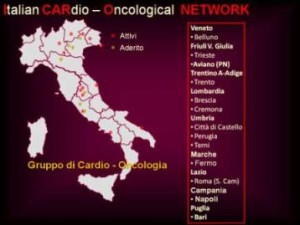Come e quando è nato ICARO
 L’idea di ICARO nasce con lo scopo di proseguire l’esperienza positiva del gruppo BRAVEHEART, del DMP-HF e del gruppo IMAGE-HF, con la formazione di un gruppo di lavoro che studiasse nel mondo reale la problematica crescente della cardiotossicità da farmaci chemioterapici.
L’idea di ICARO nasce con lo scopo di proseguire l’esperienza positiva del gruppo BRAVEHEART, del DMP-HF e del gruppo IMAGE-HF, con la formazione di un gruppo di lavoro che studiasse nel mondo reale la problematica crescente della cardiotossicità da farmaci chemioterapici.
Il presupposto fondamentale si basa sulla carenza di dati attendibili sulla sicurezza di tali farmaci nella pratica clinica quotidiana, al di fuori delle casistiche selezionate dei trials con un rigoroso studio osservazionale finalizzato a produrre evidenze dai e per i pazienti del “mondo reale” della pratica clinica quotidiana in diversi setting clinici.
Un ruolo non secondario è stato svolto anche dalla comune percezione della necessità di dare una risposta organizzativa efficace ai crescenti bisogni di salute della popolazione oncologica ad alto rischio di complicanze cardiovascolari.
Infine, come BRAVEHEART, questo gruppo di studio nasce dall’aggregazione spontanea dei suoi componenti e compie le sue ricerche autofinanziandosi e in assoluta indipendenza di programmi da altri organismi privati o pubblici.
Da chi è composto il gruppo di studio ICARO?
Il nucleo di ricerca di ICARO è composto da:
– Luigi Tarantini, Ospedale S.Martino, Belluno
– Giovanni Cioffi, Casa di Cura Villa Bianca, Trento
– Chiara Lestuzzi, Aviano
– Stefano Oliva, Bari
– Nicola Maurea , Napoli
– Giulia Russo, Trieste
– Lidia Boccardi, Roma
– Daniella Bovelli, Terni
– Giovanni Pulignano, Roma
– Andrea Di Lenarda, Trieste
– Donatella Del Sindaco, Roma
– Gianfranco Alunni, Perugia

Centri aderenti allo Studio ICARO
(Italian CARdio- Oncological study group)
Protocollo di Studio di ICARO
Comitato Esecutivo:Luigi Tarantini (Belluno), Giovanni Cioffi (Trento)
Oggetto della ricerca:
- Background:
- Modalità operative
I Centri interessati dovranno far pervenire le loro adesioni ai recapiti allegati. I Centri che si impegneranno a condurre il Progetto, riceveranno il Protoollo di studio e il file con il foglio elettronico per l’inserimento dei dati del proprio Centro e un Questionario di valutazione di fattibilità-
La durata dell’arruolamento nel Registro è di 12 mesi a partire dall’arruolamento del paziente numero 1. E’possibile, per chi disponesse di un suo personale database, anche inviare dati retrospettivi, ma solo se completi in ogni variabile. In questo caso occorrerà segnalare il dato nella lettera di accompagnamento.
La durata del follow-up minimo è di 12 mesi. E’auspicabile il proseguimento del follow-up almeno fino al mese 36. - Rif Bibliografici:
- Analisi dei dati
L’analisi statistica prevede:
– Prevalenza di disfunzione ventricolare sinistra
– Correlazioni fra variabili cliniche e DVSx
– Valutazione degli strumenti diagnsotici
– Sopravvivenza a 12 mesi
– Stratificazione prognostica dei pazienti
– Valutazione di impatto dei trattamenti preventivi - Criteri di Pubblicazione:
Saranno coautori i partecipanti individuati dal centro, ci sarà una appendice per l’estrattore dei dati. L’ordine degli autori sarà basato sul numero di pazienti inviati, la completezza e congruenza dei dati e del follow-up e la partecipazione alla stesura e alla revisione dei manoscritti.
Pubblicazioni
Heart failure in women treated with adjuvant trastuzumab for breast cancer
Tarantini L, Feola M, Albini A, Gori S, Foglietta J, Cicoira MA, Pulignano G.
G Ital Cardiol (Rome). 2012 May;13(5 Suppl 1):54S-62S.
The amplification of the HER receptor system is present in approximately 20% of breast cancers and confers a marked malignancy and a poor prognosis. Trastuzumab, a monoclonal antibody directed against the HER2 receptor, has dramatically improved the prognosis of patients with HER2+ metastatic and early breast cancer. However, the use of trastuzumab is associated with the possible development of myocardial dysfunction and heart failure. Trastuzumab-induced cardiac injury may be reversible, and a substantial proportion of patients can complete therapy. For this reason, careful monitoring of cardiac function, an aggressive treatment of hypertension and possibly the use of non-anthracycline-containing chemotherapy protocols are required during trastuzumab treatment. Owing to the selection of patients enrolled in major randomized trials, the safety profile of trastuzumab is currently unclear in elderly women, in patients at high cardiovascular risk and in those with structural heart disease on optimal treatment. Further studies are therefore needed to determine whether this highly effective therapy in breast cancer survival can be extended to such categories of patients.
Role of renal function on the development of cardiotoxicity associated with trastuzumab-based adjuvant chemotherapy for early breast cancer.
Russo G, Cioffi G, Di Lenarda A, Tuccia F, Bovelli D, Di Tano G, Alunni G, Gori S, Faggiano P, Tarantini L.
Intern Emerg Med. 2012 Oct;7(5):439-46. Epub 2012 Jun 20.
Anthracyclines, taxanes and trastuzumab are used for therapy in early breast cancer (EBC) overexpressing Human Epidermal Growth Factor 2 (HER2+). These drugs, considered alone, do not present potential nephrotoxicity. However, renal dysfunction (RD) may increase the myocardial sensibility to the insult of these chemotherapies used in combination. The aim of the study is to assess the role of RD on the development of cardiotoxicity associated with trastuzumab-based adjuvant therapy (aTrastC) for EBC. Clinical and echocardiographic data of 499 women with ERB2+ EBC were analyzed. At 12-month evaluation, any symptoms of heart failure or decrease in left ventricular ejection fraction (LVEF) were recorded. Patients who had cardiotoxicity (n = 130, 26 %) were older (57 ± 11 vs. 55 ± 11 years; p = 0.03), had lower glomerular filtration rate (GFR) (76 ± 15 vs. 83 ± 19 ml/min/1.73 m(2); p = 0.003), higher LVEF (69 ± 6 vs. 63 ± 5 %; p < 0.001) and received more frequent doses of doxorubicin (18 vs. 9 %; p = 0.01) than those who did not. In patients with GFR 60-90 and
Adjuvant trastuzumab cardiotoxicity in patients over 60 years of age with early breast cancer: a multicenter cohort analysis.
Tarantini L, Gori S, Faggiano P, Pulignano G, Simoncini E, Tuccia F, Ceccherini R, Bovelli D, Lestuzzi C, Cioffi G; ICARO (Italian CARdio-Oncologic) Network.
Collaborators (36)
Ann Oncol. 2012 Dec;23(12):3058-63. doi: 10.1093/annonc/mds127. Epub 2012 Jun 13.
BACKGROUND: Adjuvant Trastuzumab with chemotherapy is the gold standard for human epidermal growth factor receptor 2 (HER2)-positive early breast cancer (HER2+ EBC). Older patients have been largely under-represented in clinical trials, and few data on Trastuzumab cardiotoxicity have been reported in this subgroup.
PATIENTS AND METHODS: Four hundred and ninety-nine consecutive HER2+ EBC patients were treated with adjuvant trastuzumab and chemotherapy (aTrastC) at 10 Italian institutions. We evaluated disease prevalence and patient characteristics in the patients older than 60 years of age (over-60), prevalence of aTrastC cardiotoxicity and risk factors.
RESULTS: There were 160 ‘over-60’ patients (32%), in whom a higher prevalence of hypertension, diabetes, renal dysfunction, dyslipidemia and treatment with ACEi (40 versus 8%) and beta blockers (20 versus 8%) was found than in the younger patients (339 = 68%). Clinical heart failure occurred in 6% of the ‘over-60’ and in 2% of the younger patients. A reduction in left ventricular ejection fraction of >10 points was detected in 33% of the ‘over-60’ and in 23% of the younger patients (all P < 0.05). aTrastC was discontinued in 10% of the ‘over-60’ and in 4% of the younger patients (P = 0.003), restarted in 44% of the ‘over-60’ and in 58% of the younger women (P = ns).
CONCLUSION: In clinical practice, 32% of HER2+ EBC patients treated with aTrastC are ‘over-60’. These patients have an increased cardiovascular risk profile and develop aTrastC cardiotoxicity commonly.
Administration of angiotensin-converting enzyme inhibitors and β-blockers during adjuvant trastuzumab chemotherapy for nonmetastatic breast cancer: marker of risk or cardioprotection in the real world?
Oliva S, Cioffi G, Frattini S, Simoncini EL, Faggiano P, Boccardi L, Pulignano G, Fioretti AM, Giotta F, Lestuzzi C, Maurea N, Sabatini S, Tarantini L; Italian Cardio-Oncological Network.
Oncologist. 2012;17(7):917-24. doi: 10.1634/theoncologist.2011-0445. Epub 2012 Jun 6.
BACKGROUND: Adjuvant trastuzumab therapy improves the outcome of patients with early breast cancer (EBC) and overexpression of human epidermal growth factor receptor 2 (HER2). However, it is potentially cardiotoxic. This study aims to evaluate the relationship between the use of angiotensin-converting enzyme inhibitors/receptor blockers (ACEi/ARBs) and/or β-blockers and development of heart failure (HF) and/or left ventricular dysfunction during 1 year of adjuvant trastuzumab therapy.
METHODS: A total of 499 women receiving adjuvant trastuzumab therapy for EBC entered in a multicenter registry and were divided into four subgroups according to treatment with ACEi/ARBs and/or β-blockers. Occurrence of HF and decrease of left ventricular ejection fraction (LVEF; minimum 10 percentage points) were recorded.
RESULTS: HF occurred in 2% of patients who did not take either ACEi/ARBs or β-blockers, 8% of patients receiving ACEi/ARBs alone, 8% receiving β-blockers alone (p = .03), and 19% receiving both medications (p < .01). The prevalence of patients with LVEF that decreased by at least 10 percentage points was similar in all groups. Combined ACEi/ARBs and β-blocker therapy was independently associated with hypertension and a significant reduction of LVEF from baseline to 3-month evaluation. The use of ACEi/ARBs alone or β-blockers alone was predicted only by hypertension. Combined therapy of ACEi/ARBs plus β-blockers predicted LVEF recovery from the 3-month to 12-month evaluation.
CONCLUSIONS: In clinical practice, the degree of hypertension and decrease in LVEF during the first 3 months of adjuvant trastuzumab therapy for EBC are associated with the use of ACEi/ARBs and β-blockers. The combined use of these two medications is associated with a recovery of LVEF during months 3-12 of adjuvant trastuzumab therapy.
Trastuzumab adjuvant chemotherapy and cardiotoxicity in real-world women with breast cancer.
Tarantini L1, Cioffi G, Gori S, Tuccia F, Boccardi L, Bovelli D, Lestuzzi C, Maurea N, Oliva S, Russo G, Faggiano P; Italian Cardio-Oncologic Network.
Collaborators (33)
J Card Fail. 2012 Feb;18(2):113-9. doi: 10.1016/j.cardfail.2011.10.015. Epub 2011 Dec 3.
BACKGROUND: Adjuvant trastuzumab therapy improves survival of human epidermal growth factor receptor 2 (HER2)-positive women with early breast cancer (EBC). A careful monitoring of cardiac function is needed due to potential trastuzumab cardiotoxicity (Tcardiotox). To date, the incidence, timing, and phenotype of patients with Tcardiotox in clinical practice are not well known.
METHODS AND RESULTS: A total of 499 consecutive HER2-positive women (mean age 55 ± 11 years) with EBC treated with trastuzumab between January 2008 and June 2009 at 10 Italian institutions were followed for 1 year. We evaluated incidence, time of occurrence, and clinical features associated with Tcardiotox. Left ventricular ejection fraction (LVEF) was evaluated by echocardiography at baseline and at 3, 6, 9, and 12 months during trastuzumab therapy. Tcardiotox was recognized in 133 patients (27%): 102 (20%) showed asymptomatic reduction in LVEF of >10% but ≤20% (grade 1 Tcardiotox); 15 (3%) had asymptomatic decline of LVEF of >20% or <50% (grade 2); and 16 (3%) had symptomatic heart failure (grade 3). Trastuzumab was discontinued due to cardiotoxicity in 24 patients (5%) and restarted in 13 after LVEF recovery. Forty-one percent of Tcardiotox cases occurred within the first 3 months of follow-up, most prevalently in older patients with higher creatinine levels and in patients pretreated with doxorubicin and radiotherapy.
CONCLUSIONS: In clinical practice, Tcardiotox is frequent in HER2-positive women with EBC and occurs in the first 3 months of therapy. Cardiac dysfunction is mild and asymptomatic in the majority of patients. The interruption of treatment is a rare event which occurs, however, in a significantly higher percentage than reported in randomized clinical trials.
Copyright © 2012 Elsevier Inc. All rights reserved.
